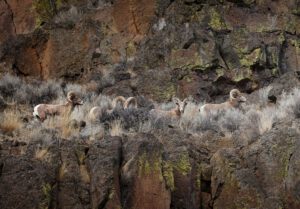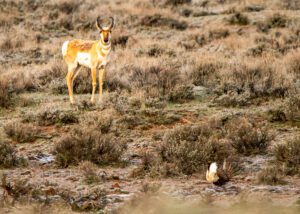Author: Renee Schiavone | Published: May 29, 2024 | Category: Where-To
This article originally appeared in The Bulletin on May 23, 2024.
Oregon’s vast, remote Greater Hart-Sheldon is home to an array of wildlife
After hours of bouncing around in my pickup on vacant dirt roads, I hardly feel alone. I haven’t seen another person all day, just hundreds of thousands of acres of sagebrush. I stop the truck and wait for the dust on the road to settle, rolling down my window to find about a dozen faces. There’s stately bighorn sheep peering down from long linear cliffs, tiny pygmy rabbits scurrying into sagebrush shrubs and pronghorn sprinting across sprawling plains. Migratory birds travel the Pacific Flyway overhead and greater sage-grouse dance on the same leks they’ve used for decades.
This is the Greater Hart-Sheldon: a region anchored by Hart Mountain National Antelope Refuge and Sheldon National Wildlife Refuge, and connected by the “Land Between” — 400,000 acres of Bureau of Land Management public land between the refuges. This vast, remote and wildlife-rich landscape is one of the largest intact swaths of Sagebrush Sea — an ecosystem scientifically known as sagebrush steppe — remaining in the West.
The Greater Hart-Sheldon has a deep history in wildlife conservation, beginning with the establishment of both Hart Mountain and Sheldon national wildlife refuges by President Roosevelt in the 1930s. The refuges were initially intended to protect pronghorn and vast lands that support the declining species, but have since provided important habitat to dozens of other sagebrush denizens in the region. The millions of acres of large, unbroken sagebrush habitats in this region are now home to hundreds of species of fish, wildlife and plants.
Denizen of the Sagebrush Sea
Fault block mountains create long linear cliffs overlooking freshwater wetlands, as well as alkaline and saline lakes, all surrounded by vast, rolling sagebrush plains. Wildflowers burst across wet meadows and wide open sagebrush is speckled with incredible rimrock. It’s quite the place to call home, so it’s no wonder so many plants and animals thrive. Here are a few you can expect to find, so long as you keep a watchful eye.
The Greater Hart-Sheldon provides essential habitat for hundreds of animals who depend on sagebrush plants – known as sagebrush obligates – including the iconic pronghorn, who cannot live without Oregon’s rolling hills of sagebrush steppe. The largest concentration of the species in the country can be found in this region, with recent studies documenting as many as 7,000 pronghorn migrating between the two refuges annually.
Other sagebrush obligates who thrive on healthy sagebrush steppe in this region are the greater sage-grouse and the pygmy rabbit. The Greater Hart-Sheldon is one of the six most important habitats remaining for greater sage-grouse and has also been identified as one of the most important core habitats for pygmy rabbits remaining in the American West. Throughout the region, find sage-grouse drawn to wet meadows of succulent wildflowers in late spring and summer or flocking to tall sagebrush for food and cover in winter. Pygmy rabbits are harder to find, most likely burrowing in the least disturbed areas of the desert with moderate sagebrush cover and plenty of undergrowth.

The California bighorn sheep was once nearly exterminated due to unregulated hunting and habitat loss but, thanks to successful translocation onto Hart Mountain National Antelope Refuge, herds from this region have since provided stock throughout the state. They continue to occupy the refuge, primarily around steep, rocky cliffs.
As early as June, hundreds of thousands of birds will flock to the northwest corner of the Greater Hart-Sheldon until early September, stopping to feed at the shores of Lake Abert along their grueling seasonal migrations. The lineup of bird species you may encounter here include American avocets, Wilson’s phalaropes, red-necked phalaropes, eared grebes, black-necked silts, willets, Western sandpipers, snowy plovers, Northern shovelers and more.
Where Wildlife Roam
Desert enthusiasts have endless opportunities to build their own adventure in this region. In total, the Greater Hart-Sheldon and surrounding landscape preserves 2.4 million acres of federally recognized wilderness-quality lands—which is also a measure of the ecological health of the region. The region is rare in the West for the amount of wilderness quality public. That’s one of the highest concentrations of wilderness values in the lower 48 states. Don’t know where to start? Here are some key spots to explore.
At the center of the region, the Hart Mountain National Antelope Refuge is an important breeding ground for species like pronghorn, sage-grouse, California bighorn sheep and more. To get started, head to Warner Valley, on the west side of the refuge, where marshland and ephemeral lakes provide habitat for wildlife to roam. From here, lush willow and aspen-filled canyons stretch to the reaches of Hart Mountain (also known as Warner Peak). Visitors can climb the mountain for overhead views or gain ground at DeGarmo Canyon, Guano Creek or one of numerous dirt roads closed seasonally to motorized vehicles, just waiting to be explored by foot.
The small springs and associated habitat on and around Beatys Butte provide critical food resources to support a variety of wildlife. This includes important winter habitat for pronghorn and year-round habitat for pygmy rabbits, western big-eared bats, ferruginous hawks, burrowing owls, desert lizards, and other mammals and birds. Most notably, the butte is part of the important area identified by the U.S. Fish and Wildlife Service for the long-term survival of the greater sage grouse. There is no developed trail to the top of Beatys or its neighboring Mahogany Butte, but hiking the 7,000+ foot peaks is still possible.
In the northwest reach of the region, Abert Rim & Lake Abert provide a desert oasis for birds and bird-lovers alike. Bighorn sheep are known to roam along Abert Rim. Overhead, look out for prairie falcons, golden eagles and great-horned owls. At Lake Abert, Oregon’s only hypersaline lake, more than 80 species of waterbirds have been observed, with over 400 in a single day at peak season!
In the southern range of the region, extending across the Oregon-Nevada border, Fish Creek Rim Wilderness Study Area sits just above the Sheldon National Wildlife Refuge. Filled with dense stands of mountain mahogany, several aspen groves and grand vistas, a healthy herd of bighorn sheep roam the rimrock here. A rugged hike and some off-trail exploration may lead you to them.

The Sagebrush Sea is the most widespread ecosystem in the United States, and it’s also one of the most threatened. Habitat loss and degradation due to development, climate change and other factors are bearing down on the spectacular array of wildlife that call the Greater Hart-Sheldon home. Oregon Natural Desert Association’s ongoing conservation campaigns aim to protect these species and the landscapes they thrive in. Visit onda.org to learn more.
—Renee Schiavone is the communications manager at Oregon Natural Desert Association, a nonprofit organization that protects and restores Oregon’s high desert public lands and waters. Read more of her work at https://onda.org/author/rschiavone/.